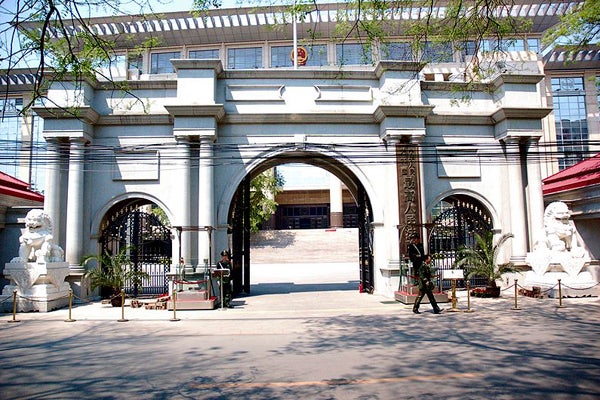|
February 7, 2012
As Chinese courts announce 'guiding cases,' Stanford Law School helps to spread the word
A Stanford website translates important rulings by the Supreme People's Court that serve as guides for lower courts, helping the vast country to move toward more consistent judicial decisions. By Stephen Tung

The main entrance to the Supreme People's Court of the People's Republic of China. (Photo: Russell Neches / Creative Commons) Legal scholars, attorneys and judges have been closely watching China's judicial system ever since the Supreme People's Court announced slightly more than a year ago that it would identify notable rulings that will direct future court decisions.
The first set of these guiding cases has been translated into English by the Stanford Law School's China Guiding Cases Project and posted on a recently launched website.
This is a significant step for a legal system that does not use binding precedents. Unlike U.S. judges who, under the common law system, must adhere to rulings of higher courts and previous decisions, judges in China's codified law system decide cases by applying statutes and are not bound to follow past court decisions. But without precedents, rulings can vary from court to court, depending on a judge's interpretation of the law. The new guiding cases system may change that.
"Guiding cases are expected to be followed by all of the courts in China," said Mei Gechlik, director of the China Guiding Cases Project.
Binding or not?
A key question with the provisions declared by the Supreme People's Court in November 2010 is whether the guiding cases are binding – whether courts must legally follow them. To do so would mark a fundamental change in the Chinese legal system.
The provisions state that "people's courts at all levels should refer to the guiding cases released by the Supreme People's Court when adjudicating similar cases," but there's no mention of whether or not the guiding cases are binding, Gechlik said.
She asked the Supreme People's Court judges she knew, "What do you mean by 'should refer to'? Are these guiding cases going to be binding? Of course the judges said, 'No! They are not going to be binding. But if these cases are not followed, there will be serious problems.'"
"In theory, they're not binding," Gechlik said. "In effect, probably they will be taken so seriously that they might evolve, one day, into something very significant. We took that cue to develop this project."
Waiting for cases
Originally, the first batch of cases was to be released in February 2011, but the release was postponed to the summer. Then it was delayed again.
"All of a sudden, the first four guiding cases were released on December 20, 2011," Gechlik said. "That gave me a very, very nice surprise – ack! a heart attack," she joked. Gechlik and her international team of law students from Stanford and China worked around-the-clock through the holidays to translate the cases to English and posted them online Jan. 9.
To her and her team's surprise, the Supreme People's Court didn't release the full court cases, but instead two- to three-page summaries of the important aspects of the case. That is understandable given the relativly inadequate experience of Chinese judges in lower courts, Gechlik said.
"In hindsight, I think it should not be a huge surprise," she said. "The Supreme People's Court probably worries that there may be mistakes in the full judgments. As a result, it summarizes and condenses the chosen judgments in a format that can be easily understood by other courts and judges."
Commentary
The four cases vary, ranging from real estate deals to out-of-court settlements. They address the legal definition of bribery as well as a delay of the death penalty for crimes committed under special circumstances. By posting them online, Gechlik's team made the abridged cases and rulings available to the public, and provided a hub for analysis and discussion. Already the team has collected and translated commentary from a Chinese judge and a former law school dean of Tsinghua University, one of the top schools in China, and is expecting more from other legal scholars.
"We hope to compile these comments together to make it easier for readers who don't have access to Chinese materials or they're simply not familiar with the Chinese legal system," Gechlik said.
She hopes to eventually organize conferences around guiding cases to discuss the implications of the decisions for legal developments inside and outside of China.
"For example, if we have guiding cases in relation to intellectual property – given that we're in Silicon Valley, we have a lot of discussions about intellectual property – these guiding cases will shed light on how intellectual property rules will be enforced. So that becomes a very crucial topic."
Other Stanford Law School projects
Not only will the China Guiding Cases Project promote discussion inside and outside of the Chinese legal community, it also will provide opportunities for students working on the project.
"It gives both Stanford students and Chinese law students an opportunity to do some hands-on, important work," said Erik Jensen, co-director of the Law School's Rule of Law Program. The China Guiding Cases Project joins other rule-of-law programs at Stanford Law School that seek to involve students with developing legal systems around the world.
Jensen guides four main projects, focusing on the legal systems of Afghanistan, Bhutan, Kurdistan and Timor-Leste. Stanford students contribute to textbooks and travel overseas to meet with local educators, legal experts and law students.
"[This is] well beyond the seminar paper that the student writes and the professor reads," Jensen said. "This is a wider initiative for experiential learning at the Law School."
Stephen Tung is an intern at the Stanford News Service.
-30-
|